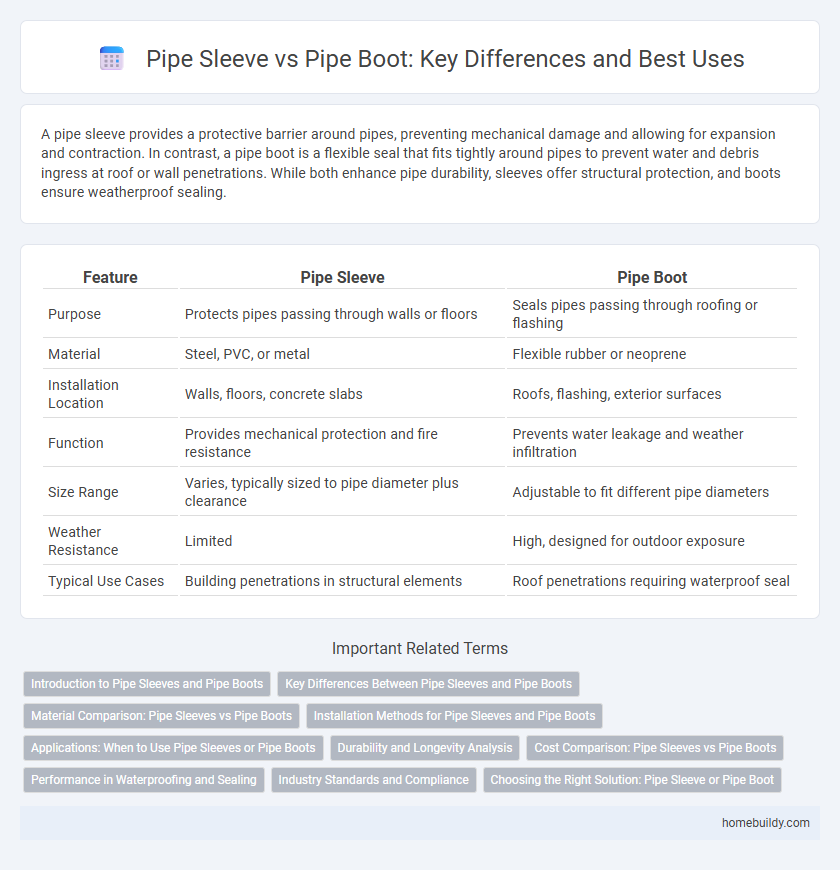A pipe sleeve provides a protective barrier around pipes, preventing mechanical damage and allowing for expansion and contraction. In contrast, a pipe boot is a flexible seal that fits tightly around pipes to prevent water and debris ingress at roof or wall penetrations. While both enhance pipe durability, sleeves offer structural protection, and boots ensure weatherproof sealing.
Table of Comparison
| Feature | Pipe Sleeve | Pipe Boot |
|---|---|---|
| Purpose | Protects pipes passing through walls or floors | Seals pipes passing through roofing or flashing |
| Material | Steel, PVC, or metal | Flexible rubber or neoprene |
| Installation Location | Walls, floors, concrete slabs | Roofs, flashing, exterior surfaces |
| Function | Provides mechanical protection and fire resistance | Prevents water leakage and weather infiltration |
| Size Range | Varies, typically sized to pipe diameter plus clearance | Adjustable to fit different pipe diameters |
| Weather Resistance | Limited | High, designed for outdoor exposure |
| Typical Use Cases | Building penetrations in structural elements | Roof penetrations requiring waterproof seal |
Introduction to Pipe Sleeves and Pipe Boots
Pipe sleeves are cylindrical protective components installed in walls or floors to allow pipes to pass through without damage or movement, providing structural support and fire resistance. Pipe boots, made from flexible materials such as rubber or silicone, seal around pipes where they penetrate roofing or walls to prevent water infiltration and environmental damage. Both pipe sleeves and pipe boots are essential for maintaining pipe integrity, but sleeves primarily offer mechanical protection while boots focus on weatherproof sealing.
Key Differences Between Pipe Sleeves and Pipe Boots
Pipe sleeves are rigid or flexible cylindrical structures designed to protect pipes as they pass through walls or floors, providing mechanical protection and preventing damage from structural shifts. Pipe boots are flexible, sealing components made primarily from rubber or elastomeric materials that create waterproof seals around pipes penetrating roofs or walls. Key differences include pipe sleeves offering structural protection and pipe boots focusing on moisture sealing and flexibility to accommodate pipe movement.
Material Comparison: Pipe Sleeves vs Pipe Boots
Pipe sleeves are typically made from rigid materials like steel, PVC, or concrete, providing enhanced structural protection and durability for pipes passing through walls or floors. Pipe boots, in contrast, are constructed from flexible and weather-resistant materials such as rubber or neoprene, ideal for sealing gaps and preventing water ingress around roof or wall penetrations. The material choice impacts performance: rigid pipe sleeves offer superior mechanical protection, while flexible pipe boots excel in waterproofing and accommodating pipe movement.
Installation Methods for Pipe Sleeves and Pipe Boots
Pipe sleeves are typically installed by embedding them into concrete walls or floors before pouring, ensuring a secure and permanent passage for pipes. In contrast, pipe boots are installed around existing pipes, with flexible sealing materials that provide easy retrofitting and waterproofing on completed surfaces. The installation of pipe sleeves requires precise planning during construction, while pipe boots offer adaptability for both new installations and repairs without major structural modifications.
Applications: When to Use Pipe Sleeves or Pipe Boots
Pipe sleeves are ideal for protecting pipes passing through walls or floors, providing structural support and fire resistance in building construction or underground installations. Pipe boots are better suited for waterproofing pipes on flat roofs or exterior walls, offering a tight seal against moisture infiltration. Choosing between pipe sleeves and pipe boots depends on the application's requirements for protection, sealing, and environmental exposure.
Durability and Longevity Analysis
Pipe sleeves offer superior durability compared to pipe boots, as they are typically made from robust materials like steel or high-density polyethylene that resist corrosion and physical damage over time. In terms of longevity, pipe sleeves provide a longer service life by protecting pipes from environmental stressors and mechanical wear, ensuring sustained structural integrity. Pipe boots, while flexible and easier to install, tend to degrade faster due to UV exposure and flexible material fatigue, resulting in reduced lifespan relative to pipe sleeves.
Cost Comparison: Pipe Sleeves vs Pipe Boots
Pipe sleeves generally offer a lower upfront cost compared to pipe boots due to simpler materials and manufacturing processes, making them a cost-effective option for basic pipe protection. However, pipe boots provide enhanced sealing and durability, which can reduce long-term maintenance expenses despite their higher initial price. Evaluating project-specific requirements and potential lifecycle costs is essential for selecting the most budget-efficient solution between pipe sleeves and pipe boots.
Performance in Waterproofing and Sealing
Pipe sleeves provide a rigid, protective barrier around pipes, ensuring structural stability and enhanced waterproofing by preventing water infiltration through concrete or masonry. Pipe boots, made of flexible rubber, excel in sealing irregular pipe shapes and allowing for movement, offering superior performance in dynamic waterproofing applications. Effective sealing depends on the right choice: pipe sleeves suit fixed installations requiring durability, while pipe boots offer adaptability and airtight waterproof seals in varied environments.
Industry Standards and Compliance
Pipe sleeves and pipe boots must adhere to stringent industry standards such as ASTM E814 and UL 1479 to ensure fire resistance and structural integrity in construction projects. While pipe sleeves primarily provide protective conduits for pipes passing through walls or floors, pipe boots offer flexible, waterproof seals around pipes, critical for waterproofing and fire-stopping compliance. Compliance with these standards guarantees safety, durability, and regulatory approval in both commercial and industrial applications.
Choosing the Right Solution: Pipe Sleeve or Pipe Boot
Selecting between a pipe sleeve and a pipe boot depends on the specific sealing and protection requirements for pipe penetrations. Pipe sleeves offer rigid support and are ideal for firestopping and structural integrity, while pipe boots provide flexible, watertight seals suitable for roofing and weatherproofing applications. Evaluating factors like environmental exposure, pipe movement, and installation depth ensures the right solution for durability and compliance.
Pipe sleeve vs Pipe boot Infographic

 homebuildy.com
homebuildy.com